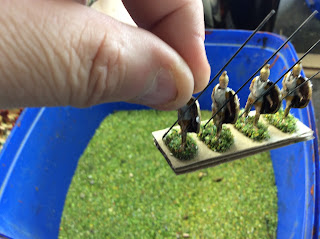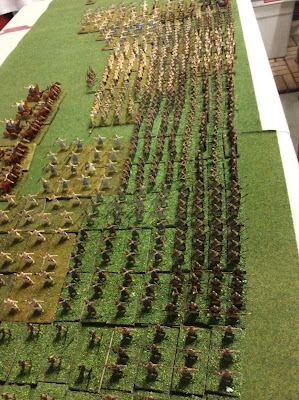My way of painting figures..
There are many ways of painting. My first soldiers were very rough! But thats OK I was learning and I live in a remote place (my nearest big city is 800 kms away!) and my town is small only about 1,500 people. So I taught myself at first painting straight onto plastic-not advised.
I buy plastic for the economy but have recently started to get into metal from mainly newline designs in the UK. They do a lot of 20mm stuff whereas most companies do 28mm or 15mm.
For me the fun part is the research, which often opens up more questions! Sometimes when I don't know I make a guess. Some figures are painting in a way which reflects colours used in some board wargames such as GMT's Great battles of the ancient world, some of my Ptolemaic have a light green colour.
I wash the figures, then I undercoat with a matt black spray. That seems to make a big difference when I first started using an undercoat I did white. I Then paint the flesh and slowly do the clothing. I might do 100 phalangists, all flesh first, then the dress, then the helmets, armour and so on normally do spears etc last.

This photo is my work area. Water bottle top left, old M&M container with pens, scissors, tweezers etc, fly spray for flies, mossies and centipedes! The plastic tray on the foreground are troops that are nearly completed in this case, HaT Persian Takabara, (couple of newline mixed in as well) and some HaT phalangists which are glued onto card. Centre back is some Army Painter which is used towards the end, the stain collects in armpits and other areas to highlight the figure nicely. Right hand side at back is a jar full of OOO brushes which are cheap and take a beating. I have an excellent supplier here in town where I pruchase these. Next to this softdrink, and container of toothpicks, for fine work with paint.
I use any type of acrylic paint. Here is some cheap brown paint which I used for the cardboard bases of the figures. I apply a liberal amount and then go to the flocking (below) where I add the grass effect.
These four HaT figures are phalangists getting ready for paint on the base and then dipped into my flock container (an old Ice Cream container does well).
Before and after paint now on base into container where they sink or swim for a while, obviously the group of troops are dry apart from base. My daughters when they were 3 and 4 did flocking for me! I came home to a bunch of Aqua and Black archers perfectly flocked. Lock up your stuff.
Above here are some Persian Takabara troops having their bases done, next they will be stuck on cupboard and then back into contained for cardboard base flocking. And here they are below all HaT figures except for one Zvezda. One day I want to give each figure a name.
 |
| Here are completed Takabara |
I paint outside in a garage, in summer it is very hot so normally do it at night in winter cold so normally during the day. I have a great view and can watch the world go by. Well not really not much is happening outside of my garage except the night the centipede attacked, thats another tale for another day. I listen to the radio and paint nice and relaxing.
 |
The view out my garage door, taken in May about noon or soon after judging by the shadows from the tree! (not tree singular this is a desert after all).
I decided to base all my units on grass even those from desert environments so when on the game map they have same bases.
|


















